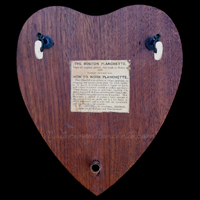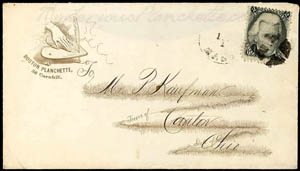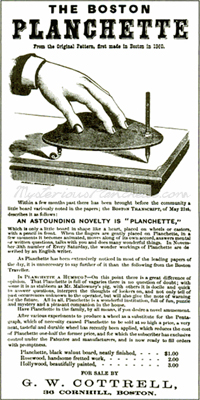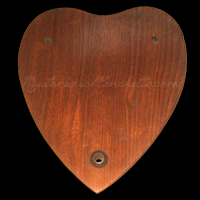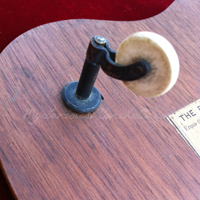For many years collectors and researchers of Spiritualist paraphernalia regarded 1868 as the year marking the introduction of the planchette in the Unites States, thus awarding the Kirby planchette the distinction as the first planchette produced on American shores. Previously, the contradictory "first made in Boston in 1860" tagline printed on each Boston Planchette was assumed to simply be a proprietorial farce meant to fend off potential patent infringements.
But newly-discovered accounts refute this assumption, and place the crown of "first" firmly on the head of G.W. Cottrell and his "Boston Planchette." The first was the discovery of a company letterhead with an 1863 stamp, that arose suspicions that the Cottrell's devices predated the First Great Craze of 1868. The second was a report in the July 20th, 1868 edition of the Springfield Republican that highlights the rising popularity of the planchette in that year, but also recounts how some 10 years previously, the prominent Spiritualist Robert Dale Owen, along with a Dr. Gardner, returned to Boston after witnessing the planchette on a trip to Paris, where it was already very much in vogue.
The pair apparently brought six of the enigmatic devices back with them, where, it was said, in 1858, Robert Dale Owen's own father, also a prominent reformer who had died that same year, communicated with him through the planchette to give him advice on a book he was writing. By 1860, the Boston bookseller G.W. Cottrell-the first publisher of a style of popular "mini-books" on etiquette and and nursery rhymes-had 50 copies made of the French specimen, which were available for sale in his stationary store at 36 Cornhill Street. In the retrospect of a decade later, the writer of the article remarks upon examining one that these early planchettes were very much "like the modern planchettes, though not so elegant in appearance"-undoubtedly a reference to the more intriguing lines and sweeping cutaway of the recently-introduced Kirby, with whom Cottrell found himself in aggressive competition.
By 1868, however, the demand for planchettes reached a fever pitch, and George Cottrell published a small 88-page booklet touting the wonders of the device titled "Revelations of Planchette." Beyond confirming the Gardner/Owen account and telling sensational stories of the device's wonders, he reported that year that he had shipped "thousands and thousands" of the items all over the country, but still could not satisfy demand. By this time, his store offered three versions of planchettes-a black walnut plank that sold for $1.00, a rosewood model with "handsome, fretted work" at $2.00, and "beautifully painted" hollywood model for $3.00.
The walnut and rosewood models of Boston Planchettes are not uncommon, although no known specimens of the hollywood model have been documented. All surviving examples carry the same classic heart shape. The castors are embedded in the plank with a coarse thread, with the head of the shank protruding through the top. Wheels are of bone supported with the classic "swoop" encasement. The pencil aperture is a separate piece of turned mahogany, often found with a degraded rubber spacer that once provided friction to hold the pencil. These planchettes are beautiful and very high quality, and deserve to have their proper provenance recognized. If you have any further information on G.W. Cottrell or his enigmatic Boston Planchettes, let us know!







